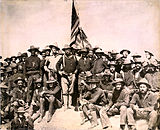George G. McMurtry
George G. McMurtry | |
|---|---|
 Medal of Honor recipient | |
| Born | November 6, 1876 Pittsburgh, Pennsylvania |
| Died | November 22, 1958 (aged 82) |
| Allegiance | United States |
| Service | United States Army |
| Years of service | 1898, 1917–1919 |
| Rank | |
| Unit | 2nd Battalion, 308th Infantry, 77th Division |
| Battles / wars | Spanish–American War
|
| Awards | Medal of Honor |
| Other work | Lawyer |
George Gibson McMurtry (November 6, 1876 – November 22, 1958) was United States Army officer, a Medal of Honor recipient and a Harvard Law-educated Wall Street lawyer.
He first served in the Army as a member of the Rough Riders during the Spanish–American War. He received the Medal of Honor as the executive officer of the Lost Battalion during World War I.
Early life
Born in Pittsburgh, Pennsylvania in 1876, McMurtry was described as a big, burly, Scottish-American, with a ruddy face who seemed to always be of good cheer. He attended law school at Harvard graduate prior to the Spanish–American War.
In the Rough Riders in the Spanish–American War
At the start of the Spanish–American War, at the age of 22, McMurtry left Harvard to serve as a member of Theodore Roosevelt's 1st US Volunteer Cavalry, known as the Rough Riders. He was a member of Troop D commanded by Captain Robert B. Huston. D Troop was part of the cavalry squadron commanded by Alexander Brodie.[1] As part of D Troop, McMurtry participated in the Battle of Las Guasimas on Friday 24 June 1898 and in the Battle of San Juan Hill on 1 July 1898.[2]
In the Lost Battalion in World War I

When the Rough Riders were disbanded, McMurtry returned to Harvard College, graduating in 1899. Like Lt. Colonel Charles Whittlesey, the leader of the Lost Battalion, he was also a Wall Street lawyer. He would later make millions of dollars in the stock market after the war.[2] He did not forget an Army career however; he obtained a commission when the Army established its first Officer Candidate Schools in May 1917. By the time World War I started, he was one of the most experienced officers of the newly formed 308th Infantry Regiment.[3]
Medal of Honor Citation

- Rank and organization: Captain, U.S. Army, 308th Infantry, 77th Division
- Place and date: At Charlevaux, Argonne Forest, France, October 2–8, 1918
- Born: November 6, 1876, Pittsburgh, Pennsylvania
- War Department, General Orders No. 118, December 2, 1918
Citation:
The President of the United States of America, in the name of Congress, takes pleasure in presenting the Medal of Honor to Captain (Infantry) George G. McMurtry, United States Army, for extraordinary heroism on October 2–8, 1918, while serving with 308th Infantry, 77th Division, in action at Charlevaux, Argonne Forest. Captain McMurtry commanded a battalion which was cut off and surrounded by the enemy and although wounded in the knee by shrapnel on 4 October and suffering great pain, he continued throughout the entire period to encourage his officers and men with a resistless optimism that contributed largely toward preventing panic and disorder among the troops, who were without food, cut off from communication with our lines. On 4 October, during a heavy barrage, he personally directed and supervised the moving of the wounded to shelter before himself seeking shelter. On 6 October, he was again wounded in the shoulder by a German grenade, but continued personally to organize and direct the defense against the German attack on the position until the attack was defeated. He continued to direct and command his troops, refusing relief, and personally led his men out of the position after assistance arrived before permitting himself to be taken to the hospital on 8 October. During this period the successful defense of the position was due largely to his efforts.
Military Awards[4]
McMurtry's military decorations and awards include:
| 1st row | Medal of Honor | Purple Heart w/one bronze oak leaf cluster | |||||||
|---|---|---|---|---|---|---|---|---|---|
| 2nd row | Spanish Campaign Medal | World War I Victory Medal w/three bronze service stars to denote credit for the Oise-Aisne, Meuse-Argonne and Defensive Sector battle clasps. | Ordre national de la Légion d'honneur degree of Knight (French Republic) | ||||||
| 3rd row | Croix de guerre 1914–1918 w/bronze palm (French Republic) | Croce al Merito di Guerra (Italy) | Орден Књаза Данила I degree of Officer (Kingdom of Montenegro) | ||||||
In popular culture
In the 2001 made-for-TV movie The Lost Battalion, McMurtry was portrayed by Phil McKee.[5][6][7]
See also
- Charles White Whittlesey
- List of Medal of Honor recipients
- List of Medal of Honor recipients for World War I
- The Lost Battalion
- McMurtry[disambiguation needed]
References
- ^ "The Rough Riders – Online Book by Theodore Roosevelt". Charles Scribners & Sons. Retrieved July 31, 2015.
- ^ a b "The Lost Battalion". Joe McCarthy. Retrieved February 20, 2008.
- ^ "The Lost Battalion". Homeofheroes.com. Retrieved July 31, 2015.
- ^ History of the 308th Infantry 1917-1919 by L. Wardlaw Miles=1927. pp. Citations Awarded to the 308th Infantry.
- ^ Medal of Honor Recipients on Film
- ^ Beyond Hollywood.com Review. Retrieved June 12, 2015.
- ^ The Lost Battalion (2001) on the Internet Movie Database. Retrieved June 12, 2015.
Further reading
- Johnson, Thomas M., and Fletcher Pratt. The Lost Battalion. Lincoln: University of Nebraska Press, 2000. ISBN 0-8032-7613-3
- Miles, L. Wardlaw. History of the 308th Infantry, 1917–1919. New York: G.P. Putnam's Sons, 1927. OCLC 5142462
- Whittlesey, Charles W. and George G. McMurtry. “The Epic of the Lost Battalion”. The New York Times, September 30, 1928.
External links
- "The Lost Battalion of World War I". Retrieved September 29, 2010.

